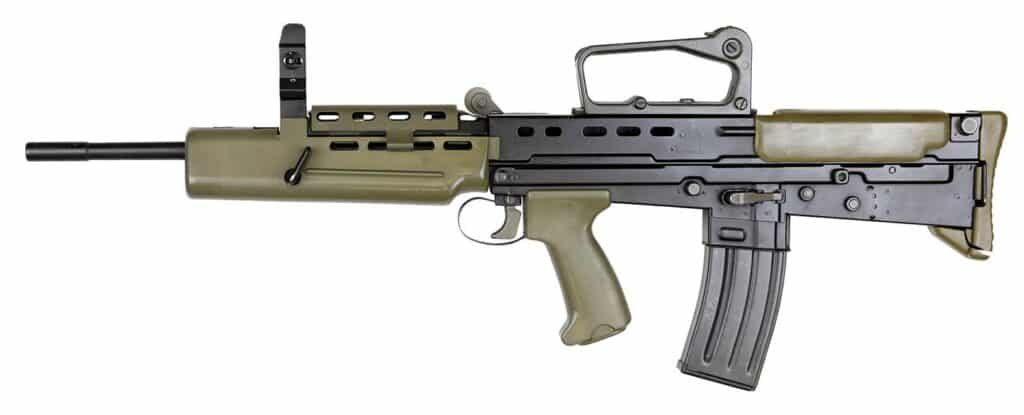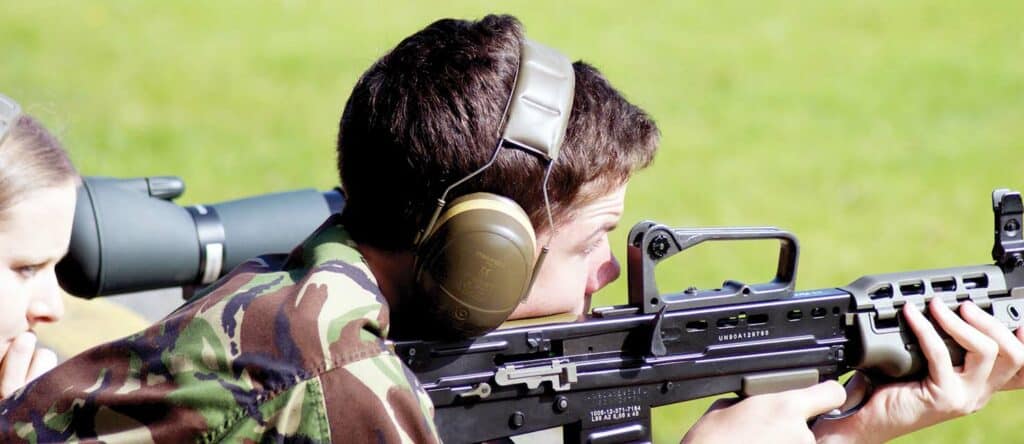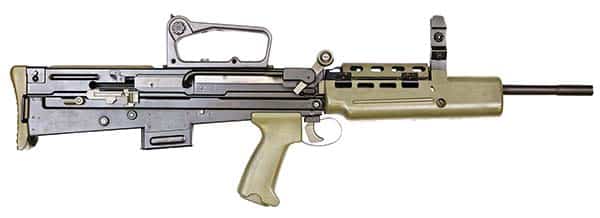In the UK there are several “Cadet” forces. These comprise the Army Cadet Force, the (RAF) Air Training Corps, the (Royal Navy) Sea Cadet Corps and the (RN and Royal Marines-affiliated) Volunteer Cadet Corps, collectively known as the “Community Cadet Forces;” all forces are open to children from age 12. The Combined Cadet Force provides the same service but does so from an embedded position within select civilian schools. These all exist as a parallel or alternative to purely civilian youth organisations such as the Scout Association. None are actually part of the military, but they are sponsored by the Ministry of Defence and run along military lines (many staff and officers are also Reservists, and training is also provided by regular soldiers). These organisations exist as a personal development opportunity and to encourage young people to join the military when they are old enough (not everyone who joins the Cadets goes on to join the military).

The Cadets’ Rifle
For this reason, Cadet forces have traditionally made use of both .22 LR caliber training rifles, such as the Lee-Enfield No.8, and “full-bore” military rifles like the .303 No.4. These teenage civilians had been permitted to shoot the self-loading 7.62x51mm SLR (FN Herstal FAL), but a decision was made in the 1980s to adopt a manually operated 5.56x45mm rifle for Cadet use. It should be noted that the subsequent UK legal restrictions on self-loading, center-fire rifled firearms—introduced in 1988—are purely coincidental. Semiautomatic firearms were legal to own in the UK when this decision was made and when the L98A1 was conceived, produced and issued. Therefore, although Enfield had an eye on exports and civilian sales, the brunt of this effort could have been borne by the self-loading-only “Super Ensign” L85A1 variant. This was designed as a semiautomatic stablemate for the manually operated Ensign (L98A1), reworked from the L85A1 as per typical civilian-legal designs sold around the world, in order to prevent ready conversion to automatic fire.
With a lack of a viable market, the technical issues with the SA80 A1 family in general and ongoing issues at the factory, only a few examples seem to have been produced, and unlike other “vaporware” British firearm designs of the period, no advertisements seem to have been produced either. However, persistent, unconfirmed rumors exist of a few examples that remain in the hands of UK shooters prior to the 1988 ban and even of examples remaining in the U.S.

An Air Cadet of 234 Squadron Air Training Corps fires the later model L98A2 Cadet GP Rifle, distinguishable from the L85A2 only by its lack of change lever (selector switch) and the markings visible here, which reveal it to have been built as an L85A1 at Royal Ordnance Nottingham in 1990.
L98A1 Trials
Trials were carried out to determine the new Cadet rifle and included a modified straight-pull German Heckler & Koch (HK) SL6 (the only non-British entrant), the Interarms EX2 (also straight-pull) and bolt-action offerings from BSA and Parker-Hale. A prototype bolt-action designed and built by British engineer John Cross (with an extremely short bolt “throw”) was also submitted. Perhaps inevitably, RSAF Enfield was selected to provide the new rifle, which was titled, “L98A1 Cadet General Purpose Rifle” (“GP” to distinguish it from the
inert “DP” or “Drill Purpose” model). This was known in-house by Enfield as the “Ensign.” The straight-pull SA80 was built using L85A1 components but critically without any “gas parts.” This necessitated a large external operating rod assembly to provide the leverage necessary to extract a fired case without disturbing the shooter’s position and hold more than necessary (although, of course, a manually operated rifle does this nonetheless).
This operating mechanism ran on a large external track screwed to the outside of the body (upper receiver) forward of the bolt carrier assembly. On the prototype example, a thick steel rod ran from the handle assembly back to the real bolt handle, which was tapped to receive the rear end of the rod. On production guns, the same rod was curved in and downward and inserted into the cocking handle aperture in the bolt carrier. The replacement bolt handle on the new assembly was made much larger and consisted of a polymer knob rotating on a central steel spindle. This in turn was attached to a short lever. When the handle is pulled back, the lever pivots against a welded-on stop on the receiver, providing leverage while the bolt is withdrawn and rotated to unlock. The unlocked bolt carrier group is then carried to the rear by the remainder of the rearward straight-pull stroke.
Minimal Changes
Other changes were minimal. With no need to conceal muzzle flash, attach a bayonet or fit a rifle grenade, the SA80 flash suppressor was eliminated, creating (arguably) a needless difference between the service rifle and the Cadet equivalent. The void inside the handguard left by the gas parts was filled by an oil bottle and mounting clips. The pistol grip is of a unique pattern, with crescent-shaped cut-outs at the bottom to allow easy removal of the pistol grip plug to access the storage compartment inside. The purpose of this is unclear, and it does not appear to have ever seen use. The same compartment exists on the standard L85/86/22 grip also, where it is a relic of the original XL60 series’ stowed, emergency backup, rear sight concept. In that case, too, the plug is not typically removed; although rumor has it that soldiers have used it as cigarette storage. It seems that some specific purpose was envisaged for the L98A1’s compartment—perhaps storage for the oil bottle that ultimately was placed under the upper handguard.
Sighting Arrangement
Although superficially identical to the backup iron sights of other SA80 weapons, the L98A1 again diverged from the family in its sighting arrangement. The front sight is a thinner blade and lacks the Tritium element of the L85A1. Rather than the simple two-position battle aperture sight of the standard carrying handle, the L98A1 version contains a rotating disc with apertures for 100m to 500m. It can be folded down to present a single 100m aperture. In actual use, however, and as units were made available, the weapon was often fitted with the standard 4x SUSAT optical sight.
A sub-variant of the L98A1 was the SA80 Competition Rifle, essentially an LSW built as per the Cadet GP rifle without gas parts and with the crank handle. In this case the intent was to provide the post-ban UK shooting community with a compliant straight-pull SA80 and one with superior accuracy. A great deal of effort was made (see Steve Raw’s, The Last Enfield, pp.213–215) to combine the LSW with the Cadet rifle, which proved more difficult than it might appear. Despite this, the product never reached market, perhaps caught up in the chaos of the Enfield factory closure. It is thought that some parts made it into the hands of firearms dealers, but the only complete weapon observed “in the wild” was that used for a time by the Royal Ordnance Rifle Club.
With the advent of the HK A2 program, a new Cadet rifle was produced from A2 upgraded parts with a new semiautomatic-only trigger mechanism (the change lever is still omitted). The pistol grip is standard L85/L86 and not the Cadet pattern. Either the standard L85 carry handle (with field sights) or the SUSAT sight is fitted. From 2009, the L98A1 was phased out
of use in favor of the L98A2; although examples no doubt still exist in Cadet armouries. It should be noted that neither variant has ever seen use in the UK military. They are strictly weapons for the Cadet forces listed above.
TECHNICAL SPECIFICATIONS
L98A1 Cadet GP Rifle
- Caliber 5.56x45mm
- Overall length 758mm
- Barrel length 519mm (20.4in)
- Weight 4.18kg (9.2lb) (unloaded with SUSAT)
- Feed device 30-round detachable magazine
• • •
Special thanks to the National Firearms Centre at the Royal Armouries, who graciously allowed us access to their world-class collection. Thanks are also due to Mike Sterry for his assistance with some of the finer technical details.
This is Part 7 in a series of articles examining the developmental history of the United Kingdom’s SA80 family of firearms. Part 6 appeared in Small Arms Review, Vol. 23, No. 8.
See armamentresearch.com for further original content.
(This article is adapted from a chapter in Mr. Ferguson’s forthcoming book on British bullpup rifles, which will be published by Headstamp Publishing in 2019. HeadstampPublishing.com).
| This article first appeared in Small Arms Review V23N9 (Nov 2019) |












